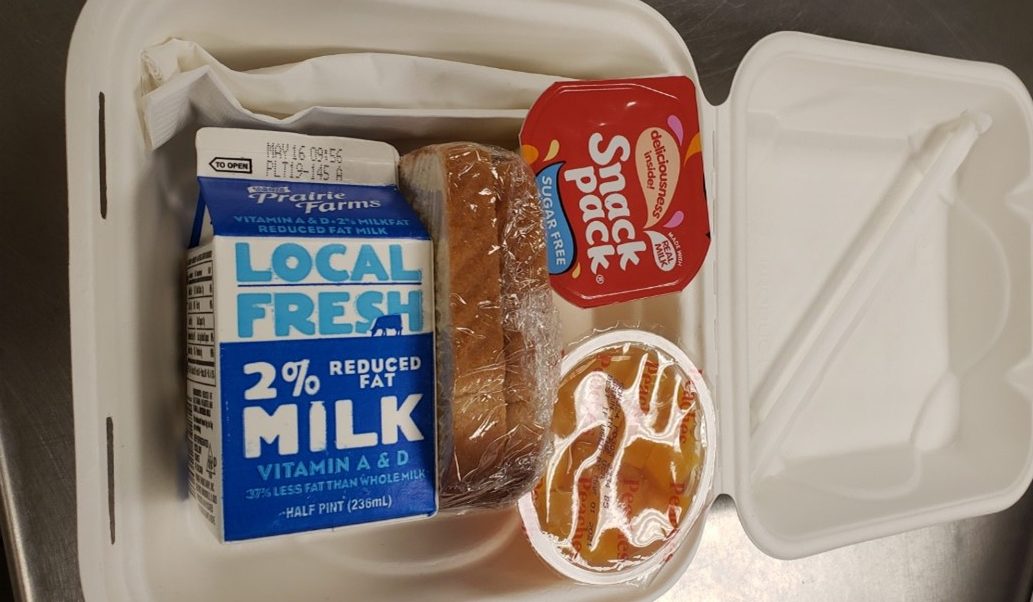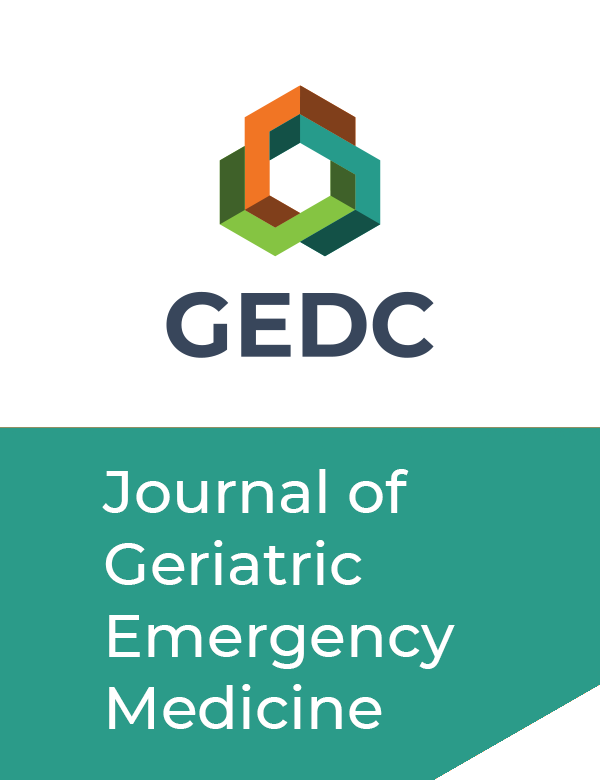Clinical Aspects of Providing a Meal for an Older Patient in the Emergency Department
Volume 2 | Issue 1 | Supplement 3
Download ArticleProviding food and drink in the emergency department (ED) is a fundamental aspect to care and comfort for those who are in need. Access to food and drink can re-engage the patient and family in a normal interaction in the context of their emergency. When our health system sought to understand the process to access food in the ED and improve our care, we found very limited guidance in the medical literature. This paper will describe the background to providing nutrition for older patients in the emergency department, a systems-based approach to providing a meal, and finally clinically relevant tips to interacting with older adults during their meal.
The American College of Emergency Physicians (ACEP) Geriatric Emergency Department Accreditation (GEDA) Guidelines describe the need for easy access to food and drink at all times for older adults in the ED.1 The intention of the GEDA guidelines is to highlight a basic need often not addressed during an extended period in the hurried ED environment. While seemingly straightforward, there are many barriers to providing meals for older patients in the ED. These include patient factors, such as disease-specific diets (e.g. diabetic or renal) and consistency modifications (e.g. pureed or mechanical soft). Facility barriers include difficulty providing food between scheduled mealtimes, inadequate staffing and/or training to obtain and assist with meals, and default NPO status for all patients.
As we prepared for GEDA accreditation across our large health system, we noted different strategies to best provide older adults with ED meals. Some sites stored meals in the ED refrigerator, while others called the hospital nursing supervisor to retrieve a meal from the hospital kitchen. While several papers have described nutrition screening for acutely ill older adults,2,3 we could find no paper describing an approach to provide meals for those receiving emergency care. Most papers describe the nutritional assessment of older adults in the context of hospital care or long-term care.4,5 We describe a standardized meal policy for older adults in the ED.
 Key components to the boxed lunch include: half a chicken salad sandwich on white bread, diced peaches, sugar free vanilla pudding, 2% milk, napkin, spoon, and straw (taken out as necessary)
Key components to the boxed lunch include: half a chicken salad sandwich on white bread, diced peaches, sugar free vanilla pudding, 2% milk, napkin, spoon, and straw (taken out as necessary)
Our health system Food and Nutrition Services collaborated with the Geriatric Emergency Department leadership to implement a standardized senior-friendly boxed lunch. Key components to the boxed lunch include: half a chicken salad sandwich on white bread, diced peaches, sugar free vanilla pudding, 2% milk, napkin, spoon, and straw (taken out as necessary) See figure. This cost is $1.90 as of August 8, 2020. The meal comes in a cardboard container with individually wrapped items. While the containers are easy to open, the nurse does set this up for our patients. The meal meets dietary requirements for those with co-morbid conditions of diabetes mellitus and cardiovascular disease. The meal does not, however, address specific allergies/ intolerance to wheat, gluten or dairy products. Additionally, the nurse assesses if the patient can or cannot have the straw. The straw is taken out for those who have difficulty swallowing. Most ED sites are provided three box lunches per day- based on the volume of patients. The un-used containers are replaced daily. While the boxed lunch was designed for older adults, it is available to ED patients of all ages. The nutrition leader helped to disseminate the program to five ED sites in Wisconsin. Each site described the process in their GEDA application. All five sites continue to use the program after certification and during the COVID-19 pandemic. We continue to disseminate this protocol to new health system sites seeking accreditation.
As an ED team develops a quality improvement program to provide meals, consider the needs of an ethnically and culturally diverse population. Further, many older individuals are vegetarian and others may be vegan. Provide alternatives to the uniform boxed lunch we describe, depending on the community your ED serves.
The Box below describes clinically relevant tips and systems- based strategies to providing nutrition for older adults in the ED. Similar to screening an older patient for gait & balance and delirium, interacting with an individual during a meal can provide important functional and social information.
Table 1: Ten Practical Tips for Providing Nutrition for Older Adults in the Emergency Department
- Unless there is a documented reason that they cannot eat, older ED patients should, by default, be allowed to eat. The nursing staff will check with the attending physician prior to ordering food. Those who are NPO status should be re-assessed every few hours. (Use clinical judgement for those with emergent surgical and cardio-respiratory conditions.)
- Eating a meal in the ED provides information pertinent to the older patient’s neurological and psychological examination. Observe their interaction with family and staff, their ability to shift and sustain attention and their level of consciousness. Further, observe their executive function: initiating their eating, problem solving and sequencing. Likewise, observe for difficulty in knowing what to do with the meal utensils (signaling an apraxia) or troubles recognizing objects of meal in front of them (signaling a possible visual field deficit).
- Because some individuals may have swallowing specifications, let the nursing staff at the bedside determine if a straw is to be used. Train the ED staff on proper hand-feeding techniques, for those who require such care.
- For individuals who have dementia and/or delirium, hunger may be expressed as distressed behaviors such as resistance to care, exit seeking, and physical aggression. Consider offering appropriate nourishment as part of the nonpharmacologic approach to distressed behavior.
- The process of providing food is more than placing the meal in front of the person. Where possible, use the meal as an opportunity to assist the patient in transferring to a bedside chair. Make sure that items are within reach and watch to see if the patient needs assistance in seeing or holding their utensils. Preparing for the meal also gives the health professional the opportunity to ask the older adult:
- how they shop for and prepare their meals;
- if they manage their moneys to pay for food;
- if they face isolation or loneliness during mealtime. Nursing staff should document the patients’ needs in their notes and reach out to case managers/ social worker, as appropriate. ED staff can provide information regarding local home delivered meals programs and senior dining centers/ meal “take-out” programs.
- When starting a nutrition quality improvement project engage staff from multiple disciplines, including nursing and dietary.
- Review the current emergency department strategy for access to food, especially afterhours. Define the workflow and any challenges for the patients, family caregivers and ED staff. Likewise, establish a protocol to clearly communicate NPO status with all staff.
- Define if the context of the ED requires your nutrition plans to address unique needs. Some sites for example serve a vulnerable homeless community. Other sites serve a community with important nutrition considerations based on faith, race or culture. Also, include documentation of the patient’s prescribed solid and liquid meal consistency (regular, thickened, pureed, etc.) during all transitions from facilities or home.
- Consider if the products in the ED meal are age-friendly. The packaging should be easy to open. The contents should not be overwhelming for those with cognitive impairment. Choose a meal that meets multiple dietary restrictions and is easy to chew. Empower and encourage all staff (nurses, aids, techs, clinicians, etc.) to ask the patient or family caregiver if they want food or drink.
- Share the ED after hours meal policy with other nutrition departments and emergency departments across your health system to standardize the policy.
Having a senior friendly boxed lunch eases the family’s stress, as it addresses a basic need during an already stressful time. It also provides the family comfort, knowing that their older adult family member’s specific nutritional needs are being met. This reassures our patients and their families that our care addresses the whole person.
Affiliations
Michael Malone, MD
Advocate Aurora Health, Director of Senior Services
Adam Perry, MD
GEDC Emergency Physician
Sandy Simonis
Advocate Aurora Health, Manager of Food Nutrition Services
Ann Gallo
Advocate Aurora Health, Project Coordinator Senior Services
Aknowledgements
Co-Editors in Chief: Michael L. Malone, MD and Teresita M. Hogan, MD, FACEP
Conflict of Interest
Michael L. Malone owns stock in Abbott Labs and Abbvie.
References
- ACEP Geriatric Emergency Department Accreditation at https://www.acep.org/geda/ Accessed August 8,2020.
- Wells JL, Dumbrell AC. Nutrition and aging: assessment and treatment of compromised nutritional status in frail elderly patients. Clin Interv Aging. 2006;1(1):67-79. doi:10.2147/ciia.2006.1.1.67
- Ahmed T, Haboubi N. Assessment and management of nutrition in older people and its importance to health. Clin Interv Aging. 2010;5:207-216. Published 2010 Aug 9. doi:10.2147/cia.s9664
- Barton AD, Beigg CL, Macdonald IA, Allison SP. A recipe for improving food intakes in elderly hospitalized patients. Clin Nutr. 2000;19(6):451-454. doi:10.1054/clnu.2000.0149
- Desai J, Winter A, Young KW, Greenwood CE. Changes in type of foodservice and dining room environment preferentially benefit institutionalized seniors with low body mass indexes. J Am Diet Assoc. 2007;107(5):808-814. doi:10.1016/j.jada.2007.02.018
